Target Costing in an Effort to Increase Profits
DOI:
https://doi.org/10.59141/jiss.v6i10.2065Keywords:
target costing, company profitAbstract
Target Costing is a strategic approach in cost management that begins with determining the selling price of a product based on market conditions and consumer preferences, then setting the expected profit, and from there determining the maximum cost allowed to produce the product. This is very good for companies to implement so that companies can manage costs well and achieve company profits. The purpose of this study is to analyze the effectiveness of implementing target costing in an effort to increase company profits. The method used is descriptive qualitative. The results of the study show that the calculation of target costing at Mazdar Collection can increase company profits by 27%, including 39% from jacket sales and 26% from sales of almamater uniforms. So Mazdar Collection should implement the target costing method in order to achieve the expected profit.
Downloads
Published
How to Cite
Issue
Section
License
Copyright (c) 2025 Bunyamin Achmad Taroji, Agung Fajar Ilmiyono, Ellyn Octavianty

This work is licensed under a Creative Commons Attribution-ShareAlike 4.0 International License.
Authors who publish with this journal agree to the following terms:
- Authors retain copyright and grant the journal right of first publication with the work simultaneously licensed under a Creative Commons Attribution-ShareAlike 4.0 International. that allows others to share the work with an acknowledgement of the work's authorship and initial publication in this journal.
- Authors are able to enter into separate, additional contractual arrangements for the non-exclusive distribution of the journal's published version of the work (e.g., post it to an institutional repository or publish it in a book), with an acknowledgement of its initial publication in this journal.
- Authors are permitted and encouraged to post their work online (e.g., in institutional repositories or on their website) prior to and during the submission process, as it can lead to productive exchanges, as well as earlier and greater citation of published work.












